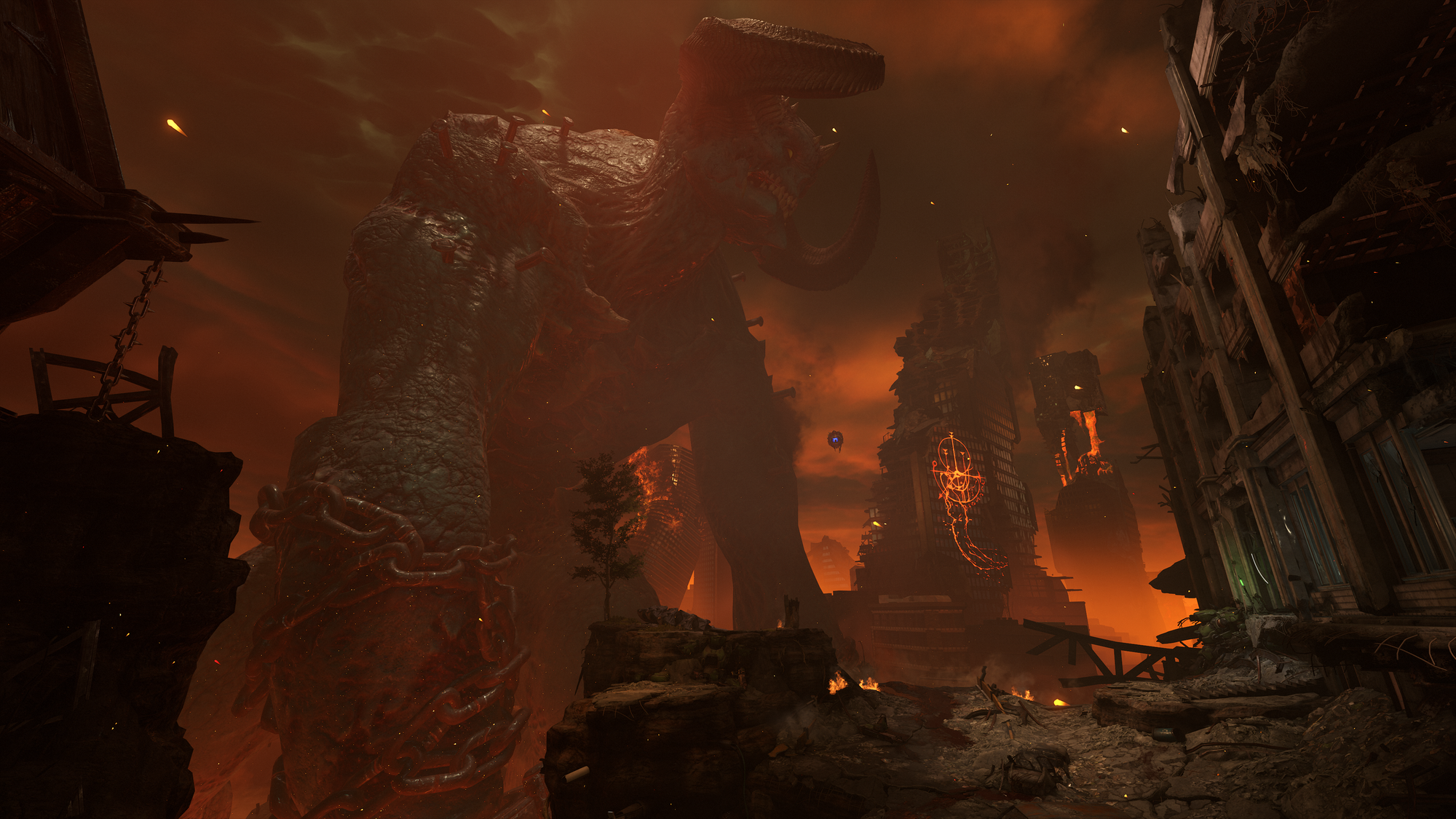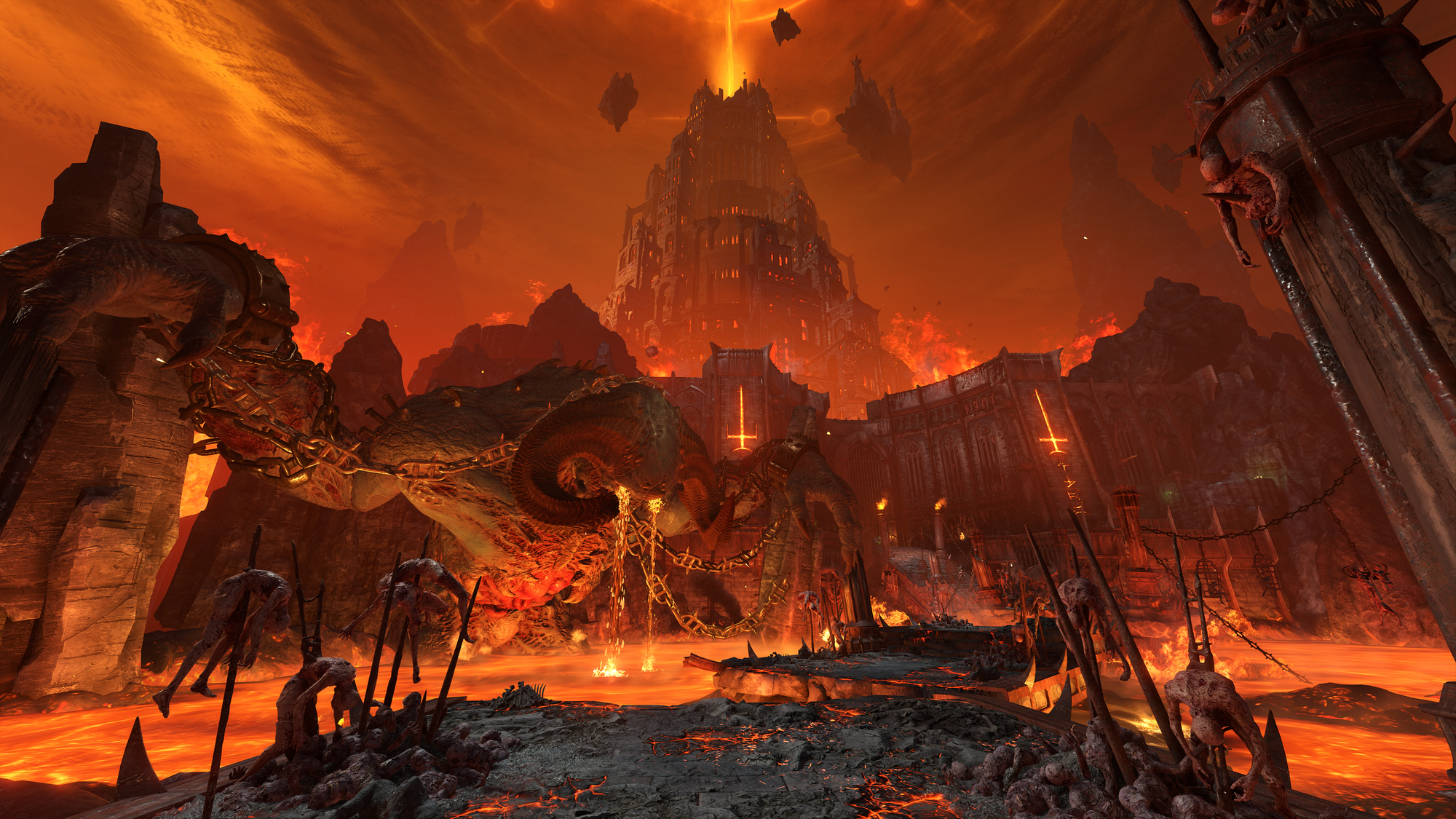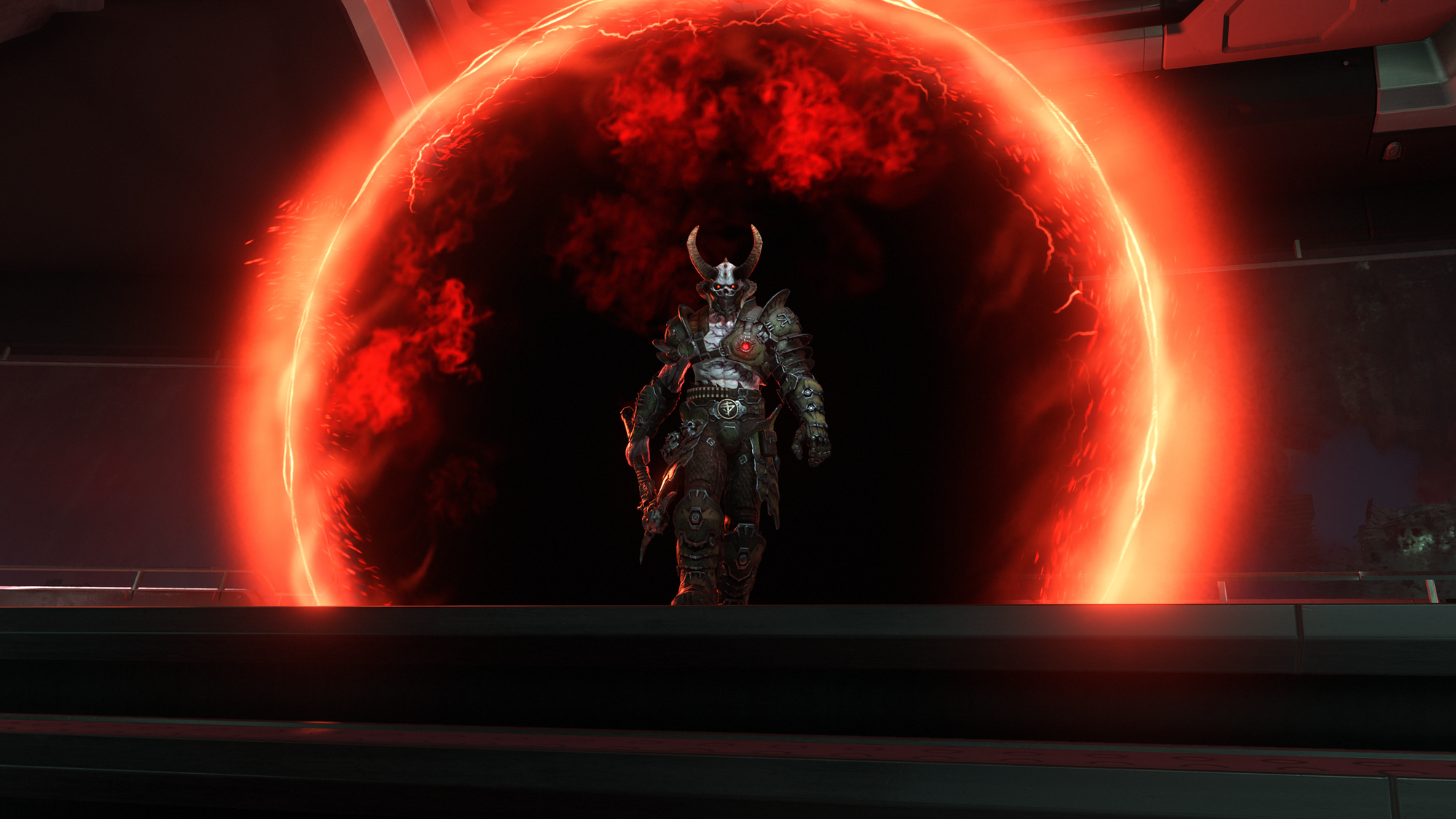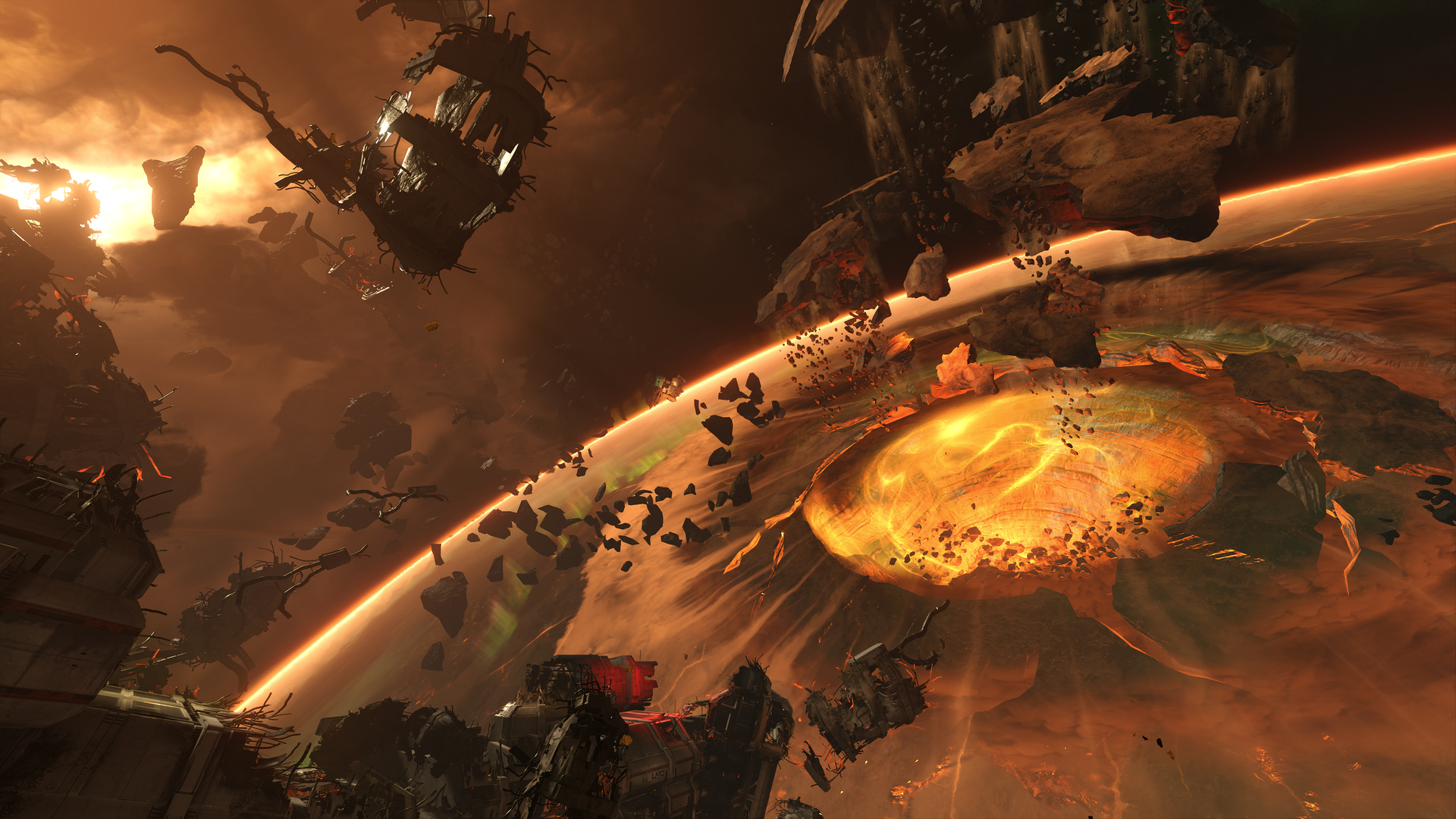If you've read my DOOM (2016) review, which you can do so here, you will know that it received heavy praise. However, in hindsight I somewhat regret giving such a high score of 9.5 / 10. It left me with little room to score DOOM Eternal, which I consider to be leagues better than DOOM (2016). Not just in terms of a DOOM game, but as an FPS action game as well. For this reason, I will refrain from summarising this review as a score out of 10, as any number that I could give would just feel wrong without amending my previous review. Additionally, I will only be covering the single-player campaign of DOOM Eternal in order to keep this review focused and concise. As much as I personally love the new asynchronous multiplayer mode, BATTLEMODE, I feel it is out of the scope of this review.

The first thing I noticed upon leaving the game's opening sequence, which doubles as a tutorial, was just how beautiful the game looks. The game has received a significant graphical upgrade over its predecessor, despite running about as well, if not better in some places. This is all due to the game running on a new version of the id Tech engine, id Tech 7, which only supports the Vulkan rendering engine on PC. This contrasts with DOOM (2016), which only had OpenGL support at launch, then adding Vulkan later down the line in a free update. Another technical improvement is the install size, Eternal weighs in at ~45GB (as of writing this review), whilst DOOM (2016) weighs in at a whopping 77GB. It is worth noting that the size of DOOM (2016) is slightly inflated by the four years of expansions and DLCs added, however the filesize at 2016's launch was still ~55GB, giving DOOM Eternal the lead anyway. This reduction in size is made even more impressive when you consider that Eternal is a much larger game, both in scope and in variety. The campaign is longer, features a much richer cast of enemy types, and has many more diverse environments to explore.
The DOOM franchise has always been about delivering a solid combat experience, and Eternal carries that torch with beauty and grace. The addition of the aerial dash, as well as swinging on bars, make for a much more vertical and fluid movement system, allowing you to efficiently route yourself around each arena, all whilst dishing out ample amounts of pain to the demons. I find myself unable to play DOOM (2016) after having spent so many hours in Eternal, as the lack of the dash makes the combat in the former feel sluggish, which is an achievement in of itself. Most of the weapons from DOOM (2016) return, with the notable exception of the pistol. Eternal now has the chainsaw, used to turn enemies' guts into a shower of ammunition, on a regenerating timer. This means you can always get more ammo, eliminating the need for the infinite ammo pistol. Some weapons have had slight changes, notably the Gauss Rifle from DOOM (2016) is now the Ballista, but all replacements serve practically the same role. The Super Shotgun has also gained the Meathook, a grappling hook attachment that pulls you right up close to whatever demon is unlucky enough to be your next target. Not only is this one of the most fun new mechanics, it works incredibly well with the new movement abilities I mentioned earlier, it allows you to get up close and personal with the knowledge you can back out to safety with a couple of well-timed dashes.
Now I cannot talk about the chainsaw without mentioning the rest of the components of what many call the "Doom Dance". These are made up of glory kills, the chainsaw, and your new flamethrower ability, the Flame Belch. Glory kills work in exactly the same way as in the previous game; once you wear down an enemy's health enough you can execute them with a quick-time event, and they explode into a shower of health pickups. The chainsaw is now - as noted before - on a regenerating timer, with two extra charges able to be stored from pickups. It has also been moved to a dedicated button, allowing its quick usage in combat. Finally, the Flame Belch ignites enemies on fire, making them drop armour shards periodically - dropping even more if the enemy is finished off while ablaze. All three of these are cooldown-based with unlimited charges; mastering all elements of the Doom Dance will mean you are always able to restock on whatever resource you are low on, no matter what. This style of gameplay pushes the player to play aggressively and encourages them to take what they need, presenting an interesting puzzle of enemy prioritisation. You may want to focus on the larger, more dangerous enemies when you are high on health. But if you take a few hits you must intelligently switch target priority to lower-tier enemies to get stocked back up. It is a cleverly designed system, which will always keep players of all skill levels on their toes.

As I hope you can see from the flavour images, DOOM Eternal is a beautiful game. The levels are vast and diverse in terms of visual design, almost every level in the campaign has a unique visual style. The levels themselves follow the same design as in the previous game, large sprawling maps broken up into arenas you must clear to progress. Some levels are purely linear, with each arena cleared progressing you deeper into the map. Others have you looping back in on yourself, clearing arenas will open up paths that were previously locked off, allowing you to progressively access more and more of the level. Each level hosts a number of optional tasks, ranging from fights and encounters, to secrets and collectibles. Going for 100% completion will keep your experience rich for much longer.
One of the new forms of optional combat encounters are the "Slayer Gates", a separate arena from the main level that houses a much harder challenge. You will encounter beefier enemies that are introduced later in the campaign's story, and have much tighter spaces to face off against them. Now I would like to briefly diverge and talk about the difficulty scaling for a moment; DOOM Eternal has four main difficulty levels, depending on your personal preference and proficiency in first-person shooters. The level of difficulty only affects the frequency of enemy attacks, so the core gameplay is the same for everyone. You effectively get to pick how much time you need to react to any given situation, which in my eyes is a great way of letting less skilled players enjoy the game, without making every enemy a bullet sponge for the more skilled players. This notion of scaling the player's reaction time ties back into slayer gates, as they seem designed to specifically put pressure on this. They test your ability to perform the Doom Dance as fast as possible. Enemies are everywhere, in a vast range of size, speed, and aggression. Some of the slayer gates are honestly my favourite arenas in the whole campaign, they keep the pace up to a point where you feel like you need a lie down and a drink afterwards, but they don't ever feel unfair or unachievable. The only criticism I can level against this new addition is the ordering of them. There are six slayer gates in total, yet I found the most difficult to be around the halfway mark, and they seem to get easier after this. This seems to be due to you completing your arsenal by this point, and the devs can't make them much harder without blindly increasing the number of enemies, which directly contradicts one of the reasons I think they are so good.
A good DOOM game would not be complete without a good cast of boss enemies. For the sake of spoilers, I will not be going into too much detail about the specifics surrounding them. The game has two mini-bosses, two regular bosses and one final boss, in that order. The pacing of the boss fights throughout the campaign is great, they scale up in difficulty to match the player's current arsenal and abilities, so even the easier bosses feel difficult at the time you encounter them. Each boss fight has a unique twist, as every good boss fight should; they all play into the new abilities given to the player nicely. One of the mini-bosses (if you have played the game, you know which one) seems to frustrate the casual player base, but to that I must disagree. Without giving too much away, the boss is designed around constantly drawing the player's focus, meaning you must be thinking harder and smarter about your target priority. Whilst this can seem unfair at first, it encourages the player to master a key element of the combat flow, which I see as a positive. Once you learn how to deal with this particular mini-boss, they become easy.

DOOM Eternal takes everything that DOOM (2016) did well and expands upon it in every way possible. The campaign was an enjoyable challenge that kept me coming back, even long after I 100%-ed it for the first time. I wholeheartedly recommend this game, even for full retail price. As of writing this review, it is only available on the XBOX Game Pass Ultimate streaming service, but it is slated to be added as a regular download in the future, so definitely be on the look-out for it there. If you enjoy first-person shooters, then DOOM Eternal should be on your radar.
